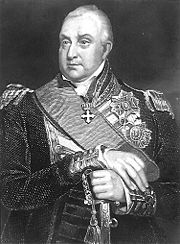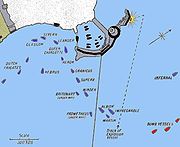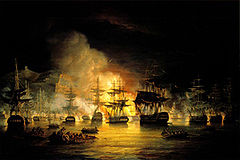
Bombardment of Algiers
Encyclopedia

United Kingdom
The United Kingdom of Great Britain and Northern IrelandIn the United Kingdom and Dependencies, other languages have been officially recognised as legitimate autochthonous languages under the European Charter for Regional or Minority Languages...
-Dutch
Netherlands
The Netherlands is a constituent country of the Kingdom of the Netherlands, located mainly in North-West Europe and with several islands in the Caribbean. Mainland Netherlands borders the North Sea to the north and west, Belgium to the south, and Germany to the east, and shares maritime borders...
fleet
Naval fleet
A fleet, or naval fleet, is a large formation of warships, and the largest formation in any navy. A fleet at sea is the direct equivalent of an army on land....
under the command of Admiral
Admiral
Admiral is the rank, or part of the name of the ranks, of the highest naval officers. It is usually considered a full admiral and above vice admiral and below admiral of the fleet . It is usually abbreviated to "Adm" or "ADM"...
Lord Exmouth
Edward Pellew, 1st Viscount Exmouth
Admiral Sir Edward Pellew, 1st Viscount Exmouth, GCB was a British naval officer. He fought during the American War of Independence, the French Revolutionary, and the Napoleonic Wars...
bombarded ships and the harbour defences of Algiers
Algiers
' is the capital and largest city of Algeria. According to the 1998 census, the population of the city proper was 1,519,570 and that of the urban agglomeration was 2,135,630. In 2009, the population was about 3,500,000...
.
Although there was a continuing campaign by various European and the American navies to suppress the piracy against Europe
Europe
Europe is, by convention, one of the world's seven continents. Comprising the westernmost peninsula of Eurasia, Europe is generally 'divided' from Asia to its east by the watershed divides of the Ural and Caucasus Mountains, the Ural River, the Caspian and Black Seas, and the waterways connecting...
ans by the North African Barbary states, the specific aim of this expedition was to free Christian slaves and to stop the practice of enslaving Europeans
Barbary Slave Trade
The Barbary Slave Trade refers to the slave markets which flourished on the Barbary Coast, or modern day Morocco, Algeria, Tunisia and western Libya between the 16th and 19th centuries. These markets prospered while the states were nominally under Ottoman rule, but in reality were mostly autonomous...
. To this end, it was partially successful as the Dey
Dey
Dey was the title given to the rulers of the Regency of Algiers and Tripoli under the Ottoman Empire from 1671 onwards...
of Algiers freed around 3,000 slaves following the bombardment and signed a treaty against the slavery of Europeans. However, the cessation of slavery did not last long.
Background
Following the end of the Napoleonic WarsNapoleonic Wars
The Napoleonic Wars were a series of wars declared against Napoleon's French Empire by opposing coalitions that ran from 1803 to 1815. As a continuation of the wars sparked by the French Revolution of 1789, they revolutionised European armies and played out on an unprecedented scale, mainly due to...
in 1815, the Royal Navy
Royal Navy
The Royal Navy is the naval warfare service branch of the British Armed Forces. Founded in the 16th century, it is the oldest service branch and is known as the Senior Service...
no longer needed the Barbary states as a source of supplies for Gibraltar
Gibraltar
Gibraltar is a British overseas territory located on the southern end of the Iberian Peninsula at the entrance of the Mediterranean. A peninsula with an area of , it has a northern border with Andalusia, Spain. The Rock of Gibraltar is the major landmark of the region...
and their fleet in the Mediterranean Sea
Mediterranean Sea
The Mediterranean Sea is a sea connected to the Atlantic Ocean surrounded by the Mediterranean region and almost completely enclosed by land: on the north by Anatolia and Europe, on the south by North Africa, and on the east by the Levant...
. There was considerable political pressure exerted to end the practice of enslaving Christians by the Barbary states.
In early 1816, Exmouth undertook a diplomatic mission, backed by a small squadron of ships of the line to Tunis
Tunis
Tunis is the capital of both the Tunisian Republic and the Tunis Governorate. It is Tunisia's largest city, with a population of 728,453 as of 2004; the greater metropolitan area holds some 2,412,500 inhabitants....
, Tripoli
Tripoli
Tripoli is the capital and largest city in Libya. It is also known as Western Tripoli , to distinguish it from Tripoli, Lebanon. It is affectionately called The Mermaid of the Mediterranean , describing its turquoise waters and its whitewashed buildings. Tripoli is a Greek name that means "Three...
, and Algiers to convince the Deys to stop the practice and free the Christian slaves. The Deys of Tunis and Tripoli agreed without any resistance, but the Dey of Algiers was more recalcitrant and the negotiations were stormy. Exmouth believed that he had managed to negotiate a treaty to stop the slavery of Christians and returned to England. However, due to confused orders, Algerian troops massacred 200 Corsica
Corsica
Corsica is an island in the Mediterranean Sea. It is located west of Italy, southeast of the French mainland, and north of the island of Sardinia....
n, Sicilian
Sicily
Sicily is a region of Italy, and is the largest island in the Mediterranean Sea. Along with the surrounding minor islands, it constitutes an autonomous region of Italy, the Regione Autonoma Siciliana Sicily has a rich and unique culture, especially with regard to the arts, music, literature,...
and Sardinia
Sardinia
Sardinia is the second-largest island in the Mediterranean Sea . It is an autonomous region of Italy, and the nearest land masses are the French island of Corsica, the Italian Peninsula, Sicily, Tunisia and the Spanish Balearic Islands.The name Sardinia is from the pre-Roman noun *sard[],...
n fishermen who were under British protection just after the treaty was signed. This caused outrage in Britain and Europe and Exmouth's negotiations were seen as a failure.
As a result, Exmouth was ordered to sea again to complete the job and punish the Algerians. He gathered a squadron of five ships of the line
Ship of the line
A ship of the line was a type of naval warship constructed from the 17th through the mid-19th century to take part in the naval tactic known as the line of battle, in which two columns of opposing warships would manoeuvre to bring the greatest weight of broadside guns to bear...
, one 50-gun ship and four frigate
Frigate
A frigate is any of several types of warship, the term having been used for ships of various sizes and roles over the last few centuries.In the 17th century, the term was used for any warship built for speed and maneuverability, the description often used being "frigate-built"...
s. —100 guns—was his flagship
Flagship
A flagship is a vessel used by the commanding officer of a group of naval ships, reflecting the custom of its commander, characteristically a flag officer, flying a distinguishing flag...
and Admiral David Milne was his second in command aboard , 98 guns. This squadron was considered by many to be an insufficient force, but Exmouth had already surveyed the defences of Algiers unobtrusively, he was very familiar with the town and was aware of a weakness in the field of fire of the defensive batteries. More large ships would merely have interfered with each other without being able to bring much more fire to bear. In addition to the main fleet, there were some transports to carry the rescued slaves and some sloops for general duties.
On arrival in Gibraltar, a squadron of five Dutch frigates and a corvette
Corvette
A corvette is a small, maneuverable, lightly armed warship, originally smaller than a frigate and larger than a coastal patrol craft or fast attack craft , although many recent designs resemble frigates in size and role...
—led by Vice-Admiral Theodorus Frederik van Capellen
Theodorus Frederik van Capellen
Vice-admiral Jonkheer Theodorus Frederik van Capellen, GCMWO, KCB was a Dutch naval officer. He was married to Petronella de Lange . Alexandrine Tinné, female explorer and pioneering photographer, was his granddaughter.-Career:Van Capellen entered service in 1781 in the navy of the Dutch Republic...
—offered to join the expedition. Exmouth decided to assign them to cover the main force from Algerian flanking batteries, as there was insufficient space in the mole
Mole (architecture)
A mole is a massive structure, usually of stone, used as a pier, breakwater, or a causeway between places separated by water. The word comes from Middle French mole and ultimately Latin mōlēs meaning a large mass, especially of rock and has the same root as molecule.Historically, the term "mole"...
for the Dutch frigates
Plan of attack


The plan of attack was for the larger ships to approach in a column. They were to sail into the zone where the majority of the Algerian guns could not be brought to bear. Then, they were to come to anchor and bombard the batteries and fortifications on the mole to destroy the defences. Simultaneously, —50 guns—was to anchor off the mouth of the harbour and bombard the shipping inside the mole. To protect Leander from the shore battery, two frigates— and —were to sail inshore and bombard the battery.
Bombardment
Pellew in Queen Charlotte anchored approximately 80 yd (73.2 m) off the mole facing the Algerian guns. However, most of the other ships, notably Admiral Milne aboard HMS Impregnable anchored out of position both reducing their effectiveness and exposing them to fiercer Algerian fire. Some of the other ships sailed past Impregnable and anchored in positions closer to the plan.
At 20:00, Milne asked that the bomb vessel Vesuvius be used against the battery that was mauling his ship. The commander of the bomb made an error of navigation and she exploded ineffectively beside the wrong battery.
Despite this, the Algerian batteries were no longer able to maintain fire and by 22:15, Exmouth gave the order for the fleet to weigh anchor and sail out of range, leaving HMS Minden to keep firing to suppress any further resistance. By 01:30 the next morning, the fleet was anchored out of range and the wounded were treated and the crew cleared the damage caused by the Algerian guns. Casualties on the British side were 16 percent killed or wounded.
Result
The following day at noon, Exmouth sent the following letter to the Dey:"Sir, for your atrocities at Bona on defenceless Christians, and your unbecoming disregard of the demands I made yesterday in the name of the Prince Regent of England, the fleet under my orders has given you a signal chastisement, by the total destruction of your navy, storehouse, and arsenal, with half your batteries.
As England does not war for the destruction of cities, I am unwilling to visit your personal cruelties upon the unoffending inhabitants of the country, and I therefore offer you the same terms of peace which I conveyed to you yesterday in my Sovereign's name. Without the acceptance of these terms, you can have no peace with England."
He warned that if they were not accepted that he would continue the action. The Dey accepted the terms, not realising that they were a bluff as the fleet had already fired off all of its ammunition.
A treaty was signed on September 24, 1816. 1,083 Christian slaves and the British Consul were freed and the ransom money repaid. Over 3000 slaves total were later freed.
Sources
- The Life of Admiral Viscount Exmouth, by William Osler, 1841
- Edward Pellew, Viscount Exmouth, by C. Northcote ParkinsonC. Northcote ParkinsonCyril Northcote Parkinson was a British naval historian and author of some sixty books, the most famous of which was his bestseller Parkinson's Law, which led him to be also considered as an important scholar within the field of public administration.-Early life and education:The youngest son of...
, 1934 - Mariner's Mirror (1941) (1817), "Dispatches from Admiral Lord Exmouth, G.C.B., addressed to John Wilson Croker, Esq," in:The Annual Register, Or, A View of the History, Politics, and Literature for the Year 1816, pp. 230–240; and "Dutch official account of the battle", ibid., pp. 240–243
External links
Algeria°N conflict=yes°W

